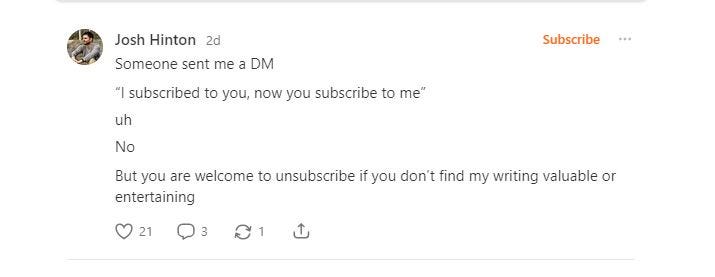Algorithm of Substack: How We Act
Substack, like Facebook or Youtube, pick up specific notes to appear in the home page. I believe there's a pattern for it.
After being a member of the Substack community for a long time and using it sophistically, I find common patterns in the notes which appear on the home pages. These patterns show how Substack, compared to other forms of social media like Facebook or Youtube, is narrower in terms of audience and prioritizes specific groups of people. This spamming tendency of the platform reflects how we connect with each other through similarities and common interests.
The Newbies
Everyday when I scroll through the Substack home page, I always see notes with these words:
The notes with words about new users and promises of subscribing back to other people if these users are subscribed constantly present themselves every day in the home page. Despite being new to the platform, they receive a lot of attention, as evidenced by the amount of likes, comments, or restacks they receive.
From this repetitive pattern of notes’ contents, the Substack platform shows its algorithm to be prioritizing the new users. For Facebook, Instagram, and Youtube, the contents from new users rarely show up, and their algorithm spawns out contents based on the recommendations and interests of the users, regardless of whether those contents come from new or old creators.
For this reason, the users of other social media would receive contents based on their interests, instead of the creators’ experiences, and Substack people only see these notes from new users which have no connection with their recommendations. This lack of consideration of the user’s taste shows Substack’s algorithm to prioritize this group of newbies, instead of the general interests of its users.
Despite the lack of taste from users in these kinds of Substack, many people still give them a lot of likes and supportive comments because it is similar to our warm welcome towards the newcomers. This reaction is due to our sympathy for them and our perception of them as little ants in a big field of grass. The pity in this situation generates an automatic reaction for people to make connections with them like a new classmate, showcasing our natural connections with the newbies.
The Writing Platform
Of course, the most obvious similarity of contents which appear in the home pages is the involvement of writing and literature. This commonality is an important part of the platform because Substack is a community for writers to share ideas and works. Other social media don’t focus on a particular subject and only have the purpose of sharing contents with other people, regardless of their topics. However, in Substack, there is also a variety of topics including science, astronomy, politics, news, and more. Despite this variance in topics, Substack still prioritizes the writing topic as the heart of its body. For this reason, most of the users from Substack are mainly writers or literature enthusiasts, and other social media’s group of audience have a large variety of users with different interests. In other words, the Substack’s group of audience is narrowed to the community of writers, not the general audience, and no matter how many topics this platform has, the priority cannot be as broad as other social media.
This lack of broadness creates a huge advantage for Substack. Because of the community of writers which get created through this platform, Substack proves itself to standout from social media such as Facebook or TikTok because it is where the writers find each other to share works and ask for help. As an effect, the narrow group of users from this platform attract other writers to use it instead of other social media, where people like them can’t be found. This pattern of behaviors reveal how we always tend to feel connected in a community of people like us and comfortable to live with it.




